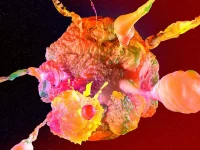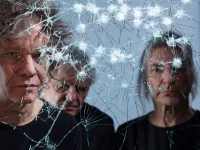The Hang: Life-changing, a chimera or just a drum?

Music. May 11 2014. There’s something mysterious about the hang. The Swiss-made musical instrument has been a kind of Holy Grail for tens of thousands of people around the world. In a rare interview its equally enigmatic makers open up about their unwanted success.
“The hang is a virus.” Felix Rohner frequently refers to his and Sabina Schärer’s creation as something infectious. Indeed, he can’t seem to keep his hands off it.
While chatting, his hands regularly stray to the strange-looking steel instrument beside him on the couch, and he hits it for emphasis.
The sound echoing around their airy riverside workshop resembles the Caribbean steel pan from which it was inspired. The first prototype was made from two leftover steel hemispheres that they stuck together.
Rohner got the steel pan bug in 1976 after hearing a Trinidadian band on the streets of Bern. “Not music but a kind of bath of sounds.” Everyone around him was dancing. “I saw the surprising impact it had on people and the next day began to make a pan out of a steel drum.”
For years he made steel pans and by the 1990s teamed up with Schärer to explore new ways of using sheet metal for instruments, eventually coming up with their hang in 2001, which they say captures “the essence of the steel band” but with added intensity of sound. Unlike steel pans, the hang is played by hand. (Hang in Bernese Swiss German dialect means hand.)
At first people could buy the new instrument in shops and demand for the unusual sounding ‘drum’ soon shot up.
But Rohner and Schärer, trading as PANArt, couldn’t keep up. “We realised that we couldn’t just work for these orders, we needed time to listen, to develop, to realise what it is all about,” recalls Schärer.Whereas many people might have capitalised on the success, Rohner and Schärer didn’t care about making money. So, to slow down demand, they changed how it was sold. Anyone wanting one had to write. Thousands of letters poured in from around the world.Prisoners, politicians, psychologists “Look at this.” Rohner pulls out an envelope dated 2009 from a file marked “not sent”. The sender has written asking for the instrument for her husband who’s in prison, one of the United States’ most notorious murderers. There’s a handwritten note from him saying how he likes the sound.
Politicians (“It’s the sound of Georgia!”), neurologists, prenatal psychologists and the esoteric were all getting in touch. “20,000 letters and everyone is talking about the same thing. They tell us the story of when they first encountered this sound,” says Rohner.
It’s the intensity of the sound that the hang makes that attracts people, according to Schärer. “It’s too much information, so you don’t know where to put it and you say, ok, I am going to let myself be overwhelmed by it. Then it makes you relax, your blood pressure goes down. It can have this effect that people are in less pain.”
The ‘chosen’ and the chancers
By creating a drip supply the instrument – and its makers – have taken on an element of mystique. Each example was selling for around CHF2,400 ($2,700) and the waiting list was long. Some hopefuls just turned up at the hang workshop, a converted butchers in an industrial estate on the Aare river in Bern.
A special welcome area had to be set up for people who were coming to pick up their instrument, as well as the unwelcome visitors. “They come from all around the world, from Alaska, Taiwan, China, all countries, and sometimes without an appointment,” says Rohner.
“You can imagine what it means when they get the news that they don’t get a hang. Then some get frustrated, aggressive, crazy, cry all day long.”
Filippo Zampieri first heard the hang on the streets of Venice. He wrote one letter trying to convey his passion for the instrument. When he heard back, he was asked to further explain his motivation. A few months later, he says he was “chosen” and drove from Italy to Bern with his parents.
“I was told that I had to choose one. I started to try them out one by one, touching them, looking for the sound, until the moment I felt something. It was clear, this was the one,” he said.
He says the hang is now like a part of his body, a way of expressing feelings and emotion. “It changed my life.”
Moving on
In the course of perfecting the hang, they have developed a new instrument, the gubal. In their workshop, dozens of the UFO-shaped objects are on display on racks. They need to sit for three months, “like wine”.
It looks similar to the hang, but acoustically, the gubal has an extra sphere, which gives it more volume and bass. It can also be tuned and has range (40 to 10,000 hertz), whereas the hang doesn’t have any stable pitch.
“This is really a new dimension. You have an orchestra in your lap. There exists no instrument like this,” says Rohner.
One hundred prototypes were given out to people to test. They are converging on the PANArt hub in May for its so-called “Gubal Days”, a time for playing together and giving feedback to the makers.
“The gubal has heart. You play what is in inside you,” explains Rohner. “The gubal has a body. The hang takes your body. You leave your body. It’s a passage instrument, you leave your body for a moment. That is why we have so much resonance around the world.”
He admits the gubal is “no longer magic” but “you can make magical music”.
Twenty-one years on, Rohner and Schärer have learnt lessons from the past. A patent has been granted on the design of the gubal. And they have begun licensing the process of treating the material, so businesses can make other instruments from it.
In a recent trademark issue the pair reached a deal with Samsung that named one of its smartphone ringtones ‘hang drum’. Samsung agreed to stop producing it.They have also drawn a line under the past. The gubal is now the only instrument PANArt are selling – a post on their website from December 2013 says no more hang are being made, and states, “letters and mails will not be answered anymore”.
“This is development,” Schärer says. “You have to leave things, you have to go on.”
“We hope it is not a virus anymore. It may be that you can even be healed from the hang by playing the gubal,” Schärer laughs. (swissinfo)










